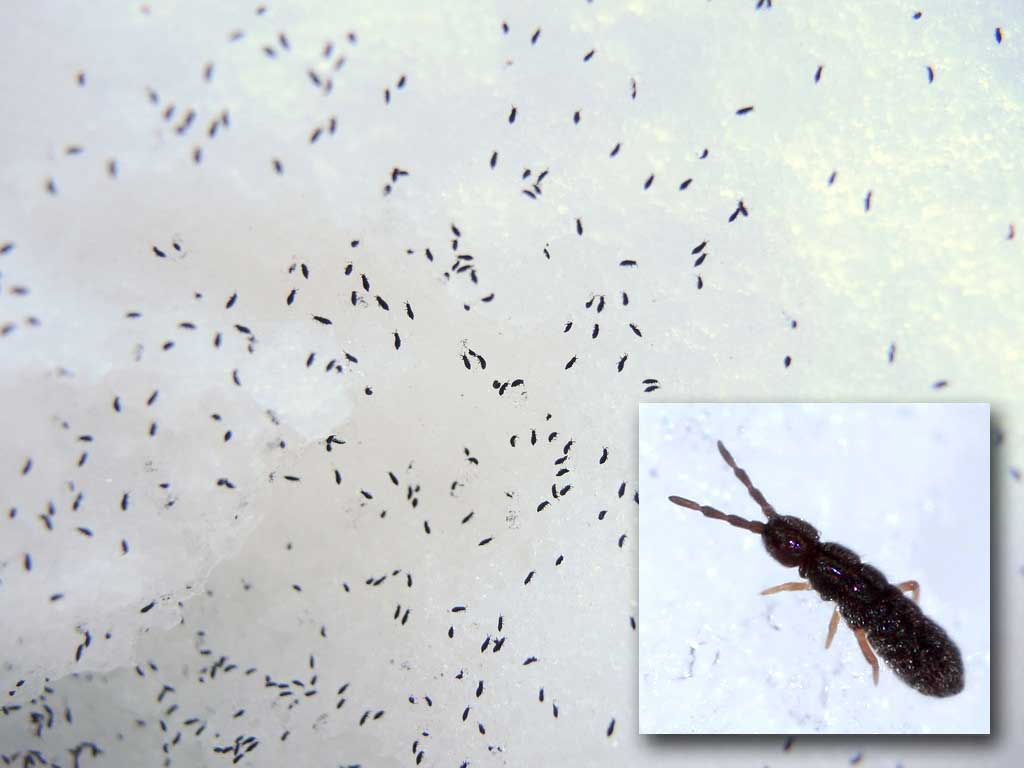Don’t flee from these fleas

Snow fleas. Photo: Per Verdonk, inset Natalija, Creative Commons, some rights reserved
If you’ve been tromping around in the woods lately, especially if it’s a mild day, you may have noticed dark specks collecting in depressions in the snow. If you look closely you’ll notice these little pepper flakes bouncing around. They’re called snow fleas, but don’t panic—they’re not real fleas.
They’re not especially fond of snow, either, but other than that, snow fleas are aptly named. On sunny days in late winter they often congregate near the bases of trees or collect in footprints. While snow fleas are the size of actual fleas, they haven’t the least interest in you or your pets (but please don’t take that personally). Try not to step on them, as they may give us the means to improve both organ transplantation and ice cream.
Snow fleas, a type of ‘springtail,’ were classified as insects until recent DNA sequencing pegged them as another type of arthropod called a hexapod. Apparently there’s now heated debate as to whether springtails constitute a hexapod class or merely a sub-class. You have to love scientists. First they study an obscure organism to develop life-saving technology, then come to fisticuffs over what to call it.
Whatever their label, snow fleas are beneficial in many ways. As decomposers of organic matter, they help create healthy topsoil. They and their hexapod cousins are one of the most abundant types of soil ‘animals,’ numbering around 100,000 individuals per cubic yard of topsoil.
Besides eating algae, fungi, nematodes, protozoa and a wide range of organic matter, they consume organisms and spores that cause damping-off wilt and other plant diseases. In fact, springtails are being studied for their potential to control plant diseases in greenhouses.
Snow fleas also produce a unique glycine-rich protein that keeps ice from forming inside their cells even at very cold temperatures. This newly discovered molecule is unlike any previously known protein, and is the basis for research on more efficient storage of transplant organs. Organs could be stored for much longer if this protein allows them to be kept at below-freezing temps without damage.
A slightly less important application, but a welcome one to many, is that snow fleas could improve ice cream. Eventually we may see ice cream that never forms ice crystals no matter how long it sits neglected in the freezer.
Springtails lack a respiratory system and must breathe through their skin. As a result, they’re quite vulnerable to drying out, and hop around to find moist, sheltered places as well as things to eat.
A true flea uses its tarsi, or toes, to vertically jump as much as seven inches, which is roughly the equivalent of a person jumping 500 feet straight up using only their toes. A snow flea, however, is not nearly so athletic. It can use its two tail-like appendages to bounce a fraction of a flea-jump, perhaps equivalent to a human leaping a mere dozen feet in the air. (I feel so much less inadequate now.)
During warmer months snow fleas and other springtails are even more active than they are in winter, although without a snowy background for contrast they’re hard to see. They forage extensively in the humus layer and move throughout the soil profile, even deep down. Springtails can be found up in the forest canopy as well as on water, where surface tension keeps them from sinking. If you go out with a flashlight some June night you can see springtails bopping about on standing water.
Just hearing the word ‘flea’ can set folks on edge and start them scratching, so it’s unfortunate about snow fleas’ name. Try thinking of them as springtails, and keep an eye out on bright winter days for these jittery critters that help make topsoil, and could one day help save our life. Or at the very least, our ice cream.
Paul Hetzler is a horticulture and natural resources educator with Cornell Cooperative Extension of St. Lawrence County.
Tags: nature, snow fleas








We have been collecting sap and I’ve seen these. Thanks for the identification and information!
Wow! In the end I got a blog from where I know how to truly get helpful facts concerning my study and knowledge.